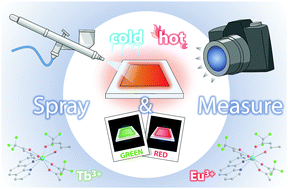Luminescence thermometry using sprayed films of metal complexes†
Abstract
Monitoring the thermal state of surfaces in real-time and in a contactless fashion is pivotal in several industrial applications and whenever the temperature of a device determines its functionality. The availability of inexpensive technologies that enable remote and reliable thermal monitoring could help overcome the limitations of infrared thermometers that stem from irradiance-dependent readouts and poor spatial resolution. In this work, we present a blueprint for a “spray and measure” luminescence thermometry approach that has broad applicative potential and does not require particular skill or expensive equipment from the side of the user. Our approach relies on the use of an airbrush to coat the surface of interest with a luminescent film made of lanthanide (Eu3+ and Tb3+) complexes. We show that the ratio between the green and red channels of digital photos of the films taken under UV excitation represents a suitable thermometric parameter. The film composition was optimized for maximal performance around room temperature through steady-state and time-resolved temperature-dependent photoluminescence studies. Colour coordinates are also shown to be usable as thermometric parameters. Foreseeably, the development of similar sprayable solutions optimized in terms of thermal sensitivity and working temperature range could spur the extensive use of this approach.



 Please wait while we load your content...
Please wait while we load your content...